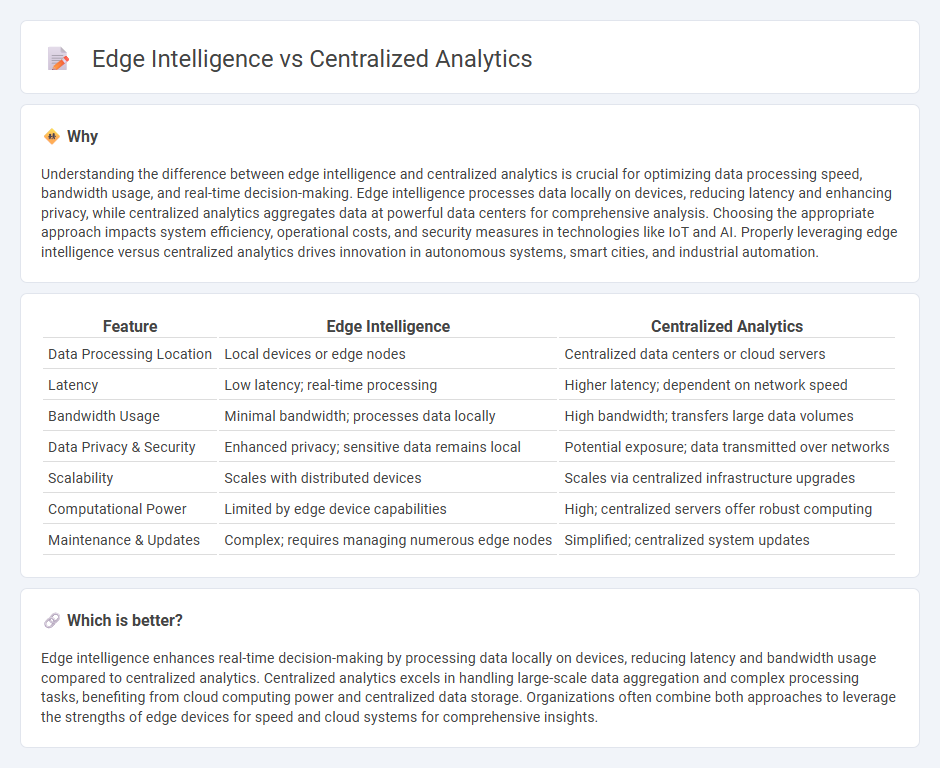
Edge intelligence processes data locally on devices at the network's edge, reducing latency and enhancing real-time decision-making compared to centralized analytics, which relies on transmitting data to a central server for processing. This decentralized approach improves security and bandwidth efficiency by limiting data exposure and reducing the volume of transmitted information. Discover how edge intelligence transforms data analysis and optimizes performance in emerging technologies.
Why it is important
Understanding the difference between edge intelligence and centralized analytics is crucial for optimizing data processing speed, bandwidth usage, and real-time decision-making. Edge intelligence processes data locally on devices, reducing latency and enhancing privacy, while centralized analytics aggregates data at powerful data centers for comprehensive analysis. Choosing the appropriate approach impacts system efficiency, operational costs, and security measures in technologies like IoT and AI. Properly leveraging edge intelligence versus centralized analytics drives innovation in autonomous systems, smart cities, and industrial automation.
Comparison Table
| Feature | Edge Intelligence | Centralized Analytics |
|---|---|---|
| Data Processing Location | Local devices or edge nodes | Centralized data centers or cloud servers |
| Latency | Low latency; real-time processing | Higher latency; dependent on network speed |
| Bandwidth Usage | Minimal bandwidth; processes data locally | High bandwidth; transfers large data volumes |
| Data Privacy & Security | Enhanced privacy; sensitive data remains local | Potential exposure; data transmitted over networks |
| Scalability | Scales with distributed devices | Scales via centralized infrastructure upgrades |
| Computational Power | Limited by edge device capabilities | High; centralized servers offer robust computing |
| Maintenance & Updates | Complex; requires managing numerous edge nodes | Simplified; centralized system updates |
Which is better?
Edge intelligence enhances real-time decision-making by processing data locally on devices, reducing latency and bandwidth usage compared to centralized analytics. Centralized analytics excels in handling large-scale data aggregation and complex processing tasks, benefiting from cloud computing power and centralized data storage. Organizations often combine both approaches to leverage the strengths of edge devices for speed and cloud systems for comprehensive insights.
Connection
Edge intelligence processes data locally on devices or near data sources to enable real-time decision-making and reduce latency. Centralized analytics aggregates data from multiple edge nodes to perform comprehensive analysis, model training, and long-term insights. The connection between edge intelligence and centralized analytics lies in their complementary roles: edge intelligence offers immediate responsiveness, while centralized analytics provides strategic oversight and refinement of AI models.
Key Terms
Data Processing Location
Centralized analytics processes data in a unified data center or cloud environment, enabling comprehensive data analysis with high computational power but often facing latency and bandwidth limitations. Edge intelligence performs data processing directly on local devices or edge servers, reducing response time, enhancing privacy, and enabling real-time decision-making closer to data sources. Explore the advantages and use cases of each approach to optimize your data strategy.
Latency
Centralized analytics relies on processing data in a remote data center, leading to higher latency due to network transmission delays, which can hinder real-time decision-making in time-sensitive applications. Edge intelligence processes data locally on edge devices, significantly reducing latency by enabling immediate computational analysis close to the data source, enhancing responsiveness and operational efficiency. Explore how edge intelligence transforms latency-sensitive industries by visiting our detailed guide.
Scalability
Centralized analytics relies on a unified data processing system, which can struggle to scale efficiently as data volume and complexity grow, often causing latency and bottlenecks. Edge intelligence distributes data processing closer to data sources, enhancing scalability by reducing network load and enabling real-time decision-making at the edge. Explore how edge intelligence offers scalable solutions for modern data ecosystems to learn more.
Source and External Links
Centralized vs. Decentralized Analytics - iDashboards - Centralized analytics involves a core data team overseeing analytics for the entire organization, enabling consistent metrics and knowledge sharing across departments, though it may slow decision-making and limit focus on specific departmental goals.
Centralized BI: What Is It & What Are the Benefits? - NetSuite - Centralized business intelligence (BI) consolidates all company data into a single location using a data warehouse, improving data security, consistency, and enabling better-informed decisions across all organizational levels.
Best practice 12.2 - Build local or build centralized data analytics platforms - AWS - Centralized analytics platforms offer benefits like increased resource use, expertise concentration, compliance, and governance, but organizations should assess trade-offs between centralized control and local team agility based on their specific needs.
 dowidth.com
dowidth.com